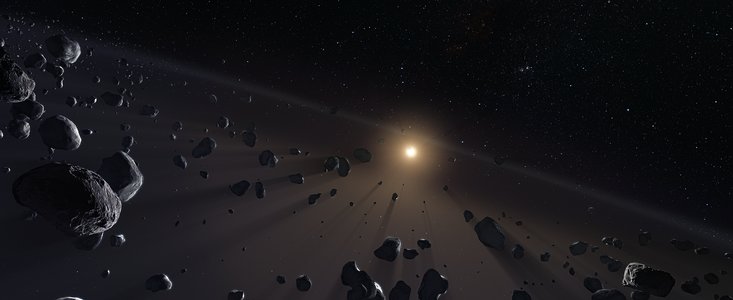Announcement
VISTA’s Zoo of Minor Planets
Data from ESO’s VISTA telescope used to extract important near-infrared properties of small bodies in the Solar System
30 June 2016
A team of European astronomers have used data from ESO’s VISTA survey telescope to catalogue a diverse population of minor planets — small bodies in the Solar System — at near-infrared wavelengths. Their study has resulted in a collection of measurements for nearly 40 000 objects, data that may help to answer key questions about the early Solar System.
Around 700 000 small objects have so far been catalogued in the Solar System, from rocky asteroids, to icy comets. By studying these objects, astronomers hope to learn about how the Solar System formed and evolved and also gather important information about possible Earth impacts.
The team examined a subset of the VISTA Hemisphere Survey that covered around 40% of the southern hemisphere of the sky. By carefully sifting through the vast amount of data from the survey, they were able to extract the position and brightness of almost 40 000 objects and colour information for around 35 000 of them. This is the first time that data from the survey have been analysed to reveal information about such a large sample of small Solar System bodies.
The colour data in particular can be used to classify the objects by deriving information about their surface compositions. The rich “fauna” identified in the catalogue includes examples from all the known categories of objects of this kind: near-Earth asteroids; Mars Crossers; Hungaria asteroids; Main Belt asteroids; Cybele asteroids; Hilda asteroids; Trojans; comets; Kuiper Belt objects; and more.
VISTA, the Visible and Infrared Survey Telescope for Astronomy, is the world’s largest survey telescope, having a mirror some 4.1 metres in diameter. With its wide field of view and very sensitive detectors it is providing astronomers with a completely new view of the southern sky. Sky surveys are a powerful tool in these days of such large and sensitive detectors. They allow astronomers to quickly catalogue large numbers of celestial objects and perform statistical analyses on them. They are ideal for astronomers searching, as here, for moving nearby objects such as asteroids and comets.
More Information
This research was presented in a paper entitled “Near-infrared colors of minor planets recovered from VISTA - VHS survey (MOVIS)”, by M. Popescu et al., that was published in the journal Astronomy & Astrophysics.
The team consists of M. Popescu (Institut de Mécanique Céleste et de Calcul des Éphémérides (IMCCE) CNRS-UMR8028, Observatoire de Paris, Paris, France; Astronomical Institute of the Romanian Academy, Bucharest, Romania), J. Licandro, D. Morate, J. de León, R. Rebolo (Instituto de Astrofísica de Canarias (IAC), La Laguna, Tenerife, Spain; Departamento de Astrofísica, Universidad de La Laguna, La Laguna, Tenerife, Spain), D. A. Nedelcu (Astronomical Institute of the Romanian Academy, Bucharest, Romania; Institut de Mécanique Céleste et de Calcul des Éphémérides (IMCCE) CNRS, Observatoire de Paris, Paris, France), R. G. McMahon (Institute of Astronomy, University of Cambridge, Cambridge, UK and Kavli Institute for Cosmology, University of Cambridge, Cambridge, UK), E. Gonzalez-Solares and M. Irwin (Institute of Astronomy, University of Cambridge, Cambridge, UK).
ESO is the foremost intergovernmental astronomy organisation in Europe and the world’s most productive ground-based astronomical observatory by far. It is supported by 16 countries: Austria, Belgium, Brazil, Czechia, Denmark, France, Finland, Germany, Italy, the Netherlands, Poland, Portugal, Spain, Sweden, Switzerland and the United Kingdom, along with the host state of Chile. ESO carries out an ambitious programme focused on the design, construction and operation of powerful ground-based observing facilities enabling astronomers to make important scientific discoveries. ESO also plays a leading role in promoting and organising cooperation in astronomical research. ESO operates three unique world-class observing sites in Chile: La Silla, Paranal and Chajnantor. At Paranal, ESO operates the Very Large Telescope, the world’s most advanced visible-light astronomical observatory and two survey telescopes. VISTA works in the infrared and is the world’s largest survey telescope and the VLT Survey Telescope is the largest telescope designed to exclusively survey the skies in visible light. ESO is a major partner in ALMA, the largest astronomical project in existence. And on Cerro Armazones, close to Paranal, ESO is building the 39-metre European Extremely Large Telescope, the E-ELT, which will become “the world’s biggest eye on the sky”.
Links
Contacts
Richard Hook
ESO Public Information Officer
Garching bei München, Germany
Tel: +49 89 3200 6655
Cell: +49 151 1537 3591
Email: rhook@eso.org
About the Announcement
| Id: | ann16042 |

